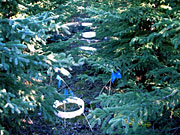- Number 352 |
- December 12, 2011
Measuring soil carbon

PVC collars placed in the
forest sampling area, located
between tree rows. Scientists
applied one of five vegetation
treatments inside each collar
to measure surface soil
respiration sources.
Carbon in, carbon out. Uncovering better methods to distinguish the sources of carbon emitted into the atmosphere was the goal of a research team led by the Joint Global Change Research Institute. The team found more efficient methods to separate components of soil respiration in forests, replacing labor-intensive techniques. JGCRI is a partnership between DOE’s Pacific Northwest National Laboratory and the University of Maryland.
These findings lead to better knowledge in a poorly understood area of the carbon cycle: distinguishing between carbon released by soil, such as plant roots and microbes, and carbon emitted by human activities. As environmental conditions change, these new techniques will provide researchers an improved understanding of how soil might gain or lose carbon.
"Carbon respiration of microorganisms and plants may respond differently to future climate changes, which is why it's important to explore how each behaves in forests," said Dr. Ben Bond-Lamberty, a scientist at JGCRI.
[Kristin Manke, 509.372.6011,
kristin.manke@pnnl.gov]
